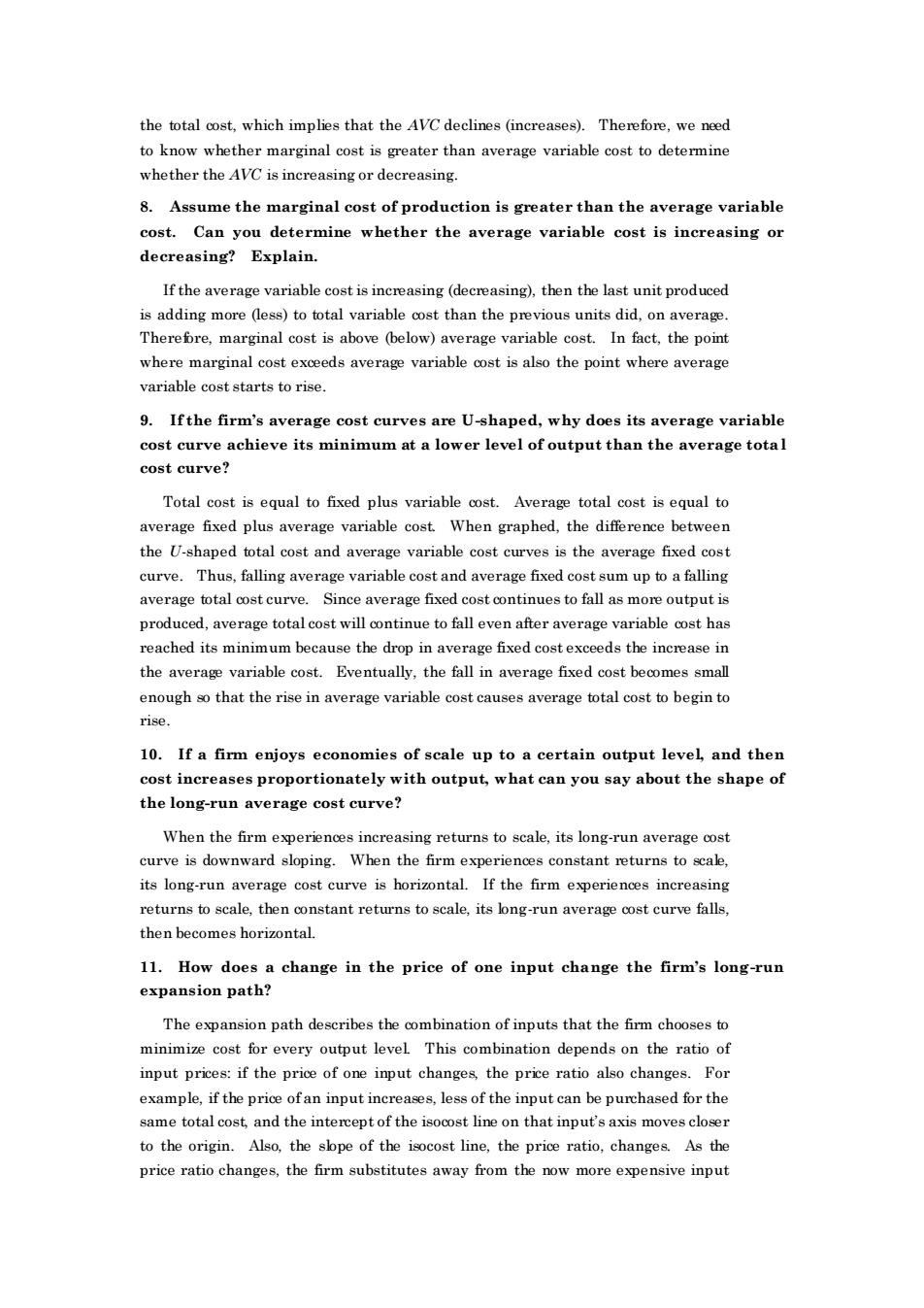正在加载图片...

the total cost,which implies that the AVC declines (increases).Therefore,we need toknow whether marginal cost is greater than average variable cost to determine whether the AVC is inereasing or deereasing. 8.Assume the marginal cost of production is greater than the average variable cost.Can you determine whether the average variable cost is increasing or decreasing?Explain. If the average variable cost is increasing(decreasing),then the last unit produced is adding more dess)to total variable oost than the previous units did.on average Therefre,marginal cost is above(below)averag variable cost.In fact.the poir where marginal variable the point where average variable cost starts to rise. 9.Ifthe firm's average cost curves are U-shaped,why does its average variable cost curve achieve its minimum at a lower level of output than the average total cost curve? Total cost is equal to fixed plus variable cost.Average total cost is equal to 套芝地u恤 tal cost and average variable cost curves is the average fixed cost curve.Thus,falling average variable cost and average fixed cost sum up to a falling average total cost curve.Since average fixed cost continues to fall as more output is produced,average total cost will continue to fall even after average variable oost has eached its min imum because the drop in average fixed cost exceeds the increase in the average variable cost. enough so that the rise in average variable cost causes average total cost to begin to rise. 10.If a firm enjoys economies of scale up to a certain output leveL and then cost increases proportionately with output,what can you say about the shape of the long-run average cost curve? When the firm erienes inc g returns to cale,its long-run ur loping Wher the constant returns to scak If the firm experiences increasing returns to scale.then constant returns to scale,its long-run average cost curve falls. then becomes horizontal. 11.How does a change in the price of one input change the firm's long-run expansion path? The expansion path describes the combination of inputs that the firm chooses to minimize cost for every ou utput level This combination depends on the ratio of input prices:if the price of one input changes,the price ratio also changes.For example,if the price ofan input increases,less of the input can be purchased for the same total cost and the intercept of the isocost line on that input's axis moves closer to the origin.Also,the slope of the isocost line.the price ratio.changes.As the price ratio changes,the firm substitutes away from the now more expensive input the total cost, which implies that the AVC declines (increases). Therefore, we need to know whether marginal cost is greater than average variable cost to determine whether the AVC is increasing or decreasing. 8. Assume the marginal cost of production is greater than the average variable cost. Can you determine whether the average variable cost is increasing or decreasing? Explain. If the average variable cost is increasing (decreasing), then the last unit produced is adding more (less) to total variable cost than the previous units did, on average. Therefore, marginal cost is above (below) average variable cost. In fact, the point where marginal cost exceeds average variable cost is also the point where average variable cost starts to rise. 9. If the firm’s average cost curves are U-shaped, why does its average variable cost curve achieve its minimum at a lower level of output than the average total cost curve? Total cost is equal to fixed plus variable cost. Average total cost is equal to average fixed plus average variable cost. When graphed, the difference between the U-shaped total cost and average variable cost curves is the average fixed cost curve. Thus, falling average variable cost and average fixed cost sum up to a falling average total cost curve. Since average fixed cost continues to fall as more output is produced, average total cost will continue to fall even after average variable cost has reached its minimum because the drop in average fixed cost exceeds the increase in the average variable cost. Eventually, the fall in average fixed cost becomes small enough so that the rise in average variable cost causes average total cost to begin to rise. 10. If a firm enjoys economies of scale up to a certain output level, and then cost increases proportionately with output, what can you say about the shape of the long-run average cost curve? When the firm experiences increasing returns to scale, its long-run average cost curve is downward sloping. When the firm experiences constant returns to scale, its long-run average cost curve is horizontal. If the firm experiences increasing returns to scale, then constant returns to scale, its long-run average cost curve falls, then becomes horizontal. 11. How does a change in the price of one input change the firm’s long-run expansion path? The expansion path describes the combination of inputs that the firm chooses to minimize cost for every output level. This combination depends on the ratio of input prices: if the price of one input changes, the price ratio also changes. For example, if the price of an input increases, less of the input can be purchased for the same total cost, and the intercept of the isocost line on that input’s axis moves closer to the origin. Also, the slope of the isocost line, the price ratio, changes. As the price ratio changes, the firm substitutes away from the now more expensive input